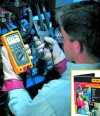

As distribution systems and loads become more complex, the possibilities of transient overvoltages increase. Motors, capacitors and power conversion equipment, such as variable speed drives, can be prime generators of spikes. Lightning strikes on outdoor transmission lines also cause extremely hazardous high-energy transients. If you are taking measurements on electrical systems, these transients are `invisible' and largely unavoidable hazards. They occur regularly on low-voltage power circuits, and can reach peak values to the order of many thousands of volts. To protect you against transients, safety must be built into the test equipment.
Safety is everyone's responsibility but ultimately it is in your hands. No tool by itself can guarantee your safety when working with electricity. It is the combination of the right tools and safe work practices that gives you maximum protection. Here are a few tips to help you in your work:
1. Make sure you always comply with (local) regulations.
2. Work on de-energised circuits whenever possible.
Use proper lock-out/tag-out procedures. If these procedures are not in place or enforced, assume that the circuit is live.
3. Use protective gear when working on live circuits.
- Use insulated tools.
- Wear safety glasses or a face shield.
- Wear insulated gloves, and remove watches or jewellery.
- Stand on an insulated mat.
- Wear flame resistant clothing, not ordinary work clothes.
4. Select the right test tool.
- Choose a test tool rated to the highest category and voltage for which it could possibly be used (most often 600 or 1000 V CAT III and/or 600 V CAT IV).
- Look for the category and voltage marking near the recessed input connectors of your test tool and a 'double insulated' symbol on the back.
- Verify your test tool has been tested and certified by two or more independent testing laboratories, such as UL in the United States and VDE or TÜV in Europe by looking for the symbols of these agencies on (the back of) your test tool.
- Make sure that the test tool is made of a high-quality, durable non-conductive material.
- Check the manual to verify that the ohms, continuity and capacitance circuits are protected to the same level as the voltage test circuit, to reduce hazards when the test tool is used incorrectly in ohms, continuity or capacitance mode (if applicable).
- Verify that the test tool has internal protection to prevent instrument damage when voltage is incorrectly applied to an amperage measurement function (if applicable).
- Make sure that the amperage and voltage of your test tool's fuses meets specifications. Fuse voltage must be as high or higher than the test tool's voltage rating.
- Be sure to use test leads that have shrouded connectors, finger guards and a non-slip surface, category ratings that equal or exceed those of the test tool, double insulation (look for the symbol), and a minimum of exposed metal on the probe tips.
5. Inspect and test your test tool.
- Check for a broken case, worn test leads or a faded display.
- Make sure the batteries still deliver sufficient power to get reliable readings. Many test tools have a low battery indicator on the display.
- Check the test leads resistance for internal breaks while moving the leads around (good leads measure 0,1 to 0,3 Ω).
- Use the meter's own test capability to ensure that the fuses are in place and working right (see manual for details).
6. Apply the appropriate working practices when measuring on live circuits.
- Hook on the ground clip first, then make contact with the hot lead. Remove the hot lead first, the ground lead last.
- Use the three-point test method, especially when checking to see if a circuit is dead. First, test a known live circuit. Second, test the target circuit. Third, test the live circuit again. This verifies that your test tool worked properly before and after the measurement.
- Hang or rest the test tool if possible. Try to avoid holding it in your hands, to minimise personal exposure to the effects of transients.
- Use the old electrician's trick of keeping one hand in your pocket. This lessens the chance of a closed circuit across your chest and through your heart.
For more information contact Val Verwer, Comtest Distribution, +27 (0) 11 254 2200, [email protected]
| Tel: | +27 10 595 1824 |
| Email: | [email protected] |
| www: | www.comtest.co.za |
| Articles: | More information and articles about Comtest |

© Technews Publishing (Pty) Ltd | All Rights Reserved